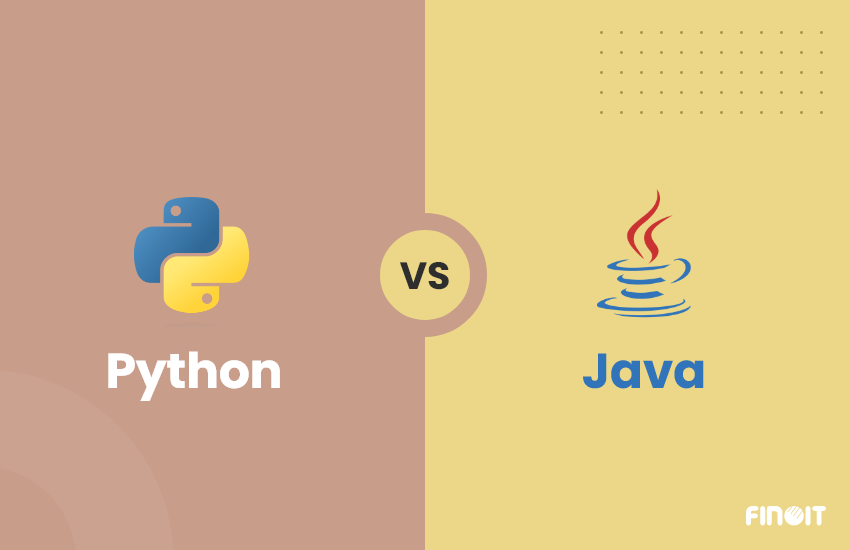Python vs. Java: A Detailed Comparison to Make Your Decision Easy

When you decide to develop an application, there’s a question that keeps popping up: Java or Python? It’s like choosing between two fantastic options for your next big project.
Java, the seasoned veteran, has been a popular choice among developers for quite some time. But then, Python entered the scene with a unique appeal—its simplicity. This simplicity quickly caught the attention of many, sparking a debate between the two contenders.
Java vs. Python became favorites among developers due to their extensive libraries and capabilities. The question on everyone’s lips: “Java or Python, which is the way forward? Each had its strengths and drawbacks, making the choice intriguing.
Speaking of popularity, according to Stack Overflow’s annual survey, JavaScript has maintained its reign as the most popular language for the eighth consecutive year. Nonetheless, Python (44.1%) and Java (40.2%) boast an incredibly close percentage of users.
So, if you stand at the crossroads of deciding between Java vs. Python for your coding journey, fear not. This guide aims to guide you through the comparison between the two programming languages and assist you in finding the best match for your project.
Comparing Python vs Java to arriving at a choice
We have identified multiple comparison parameters to analyze Python and Java, so that you can pragmatically make the selection for your development project.
Language
Python:
When considering the top reasons to choose Python, its status as an interpreted language stands out. Python swiftly transforms human-readable code into machine-executable instructions on the fly, allowing developers to review and debug their code in real time. This dynamic interpretation not only simplifies the coding process but also fosters agility in project development, making it an attractive option for programmers.
Java:
In contrast, Java is a compiled language operating under a different paradigm. Compiled languages perform a translation pattern wherein the source code is meticulously converted into machine code before execution. This preparatory act readies the code for optimized performance and security. However, the cost of this meticulous translation is a lengthier preparation phase before running the program.
Syntax
Python
Python, dynamically typed, simplifies the coding process. Developers omit variable typing, and values are input at runtime, fostering a streamlined, reader-friendly language. Python’s indentation-based code blocks enhance readability and eliminate the need for enclosing braces, making it user-intuitive.
Variable Declaration:
x, y = 12, 10
isTrue = True
greeting = “Welcome!”
Java
Conversely, Java enforces rigorous syntax rules and necessitates explicit variable typing. Errors impede program execution, potentially frustrating beginners. Unlike Python’s indentation approach, Java requires braces for the method or block definition.
Variable Declaration:
public class Main {
public static void main(String[] args) {
int x = 12, y = 10;
boolean isTrue = true;
String greeting = “Welcome!”;
}
}
Typing
Python
Python’s dynamic typing allows you to create variables without explicitly stating their data types. This flexibility speeds up coding as you don’t need to spend time declaring types. However, the trade-off is that unexpected errors can pop up during runtime. For example, changing a variable’s value to a different type later in your code might cause issues when your program runs.
Java
In Java and Python comparison, static typing requires you to declare the data type of a variable when you create it. This upfront clarity helps catch errors during compilation before your program even runs. While this might make your code longer and less flexible than Python, it offers a safety net against certain runtime errors. Java’s emphasis on reliability and predictability in coding aligns with this approach, prioritizing thorough type management for code stability.
Portability
Python
Python follows the rule of “write once, run anywhere,” which means the code you create can work on different computers and systems without much change. It’s like making a cake recipe that works in different kitchens. Python’s special tool, the interpreter, helps your code understand and work with different types of computers. So, whether you’re using Windows, Mac, or something else, your Python code can easily fit in and do its job.
Java
Now the question comes, is Java similar to Python as Java also loves the “Write Once, Run Anywhere” idea? But it has a clever friend called the Java Virtual Machine (JVM) that helps. When you write Java code, it turns into a special code called bytecode, a secret code that computers everywhere can understand. The JVM on each computer turns this secret code into regular code that the computer can follow. So, your Java program can hop between computers, from Windows to Linux, without a hitch. This helps save time and effort in making the same program work on different systems.
Database Handling
Python
When it comes to handling and playing with data, the question that pops into developers’ heads is whether Java is better or Python, so here, python is great. It’s known for its skills in analyzing and changing data. Think of it as having special tools like Pandas and NumPy that simplify data tasks. Pandas help clean and analyze data, while NumPy is like a superhero for big math stuff.
For example, Pandas can help you clean up messy data, and NumPy can handle big numbers and math calculations. Python is your go-to when you want to work with data coolly and efficiently.
Java:
If you see Java and Python differences, then Java has different data than Python, but it’s got another trick up its sleeve. It is Java faster than Python, with extensive databases that businesses use. It uses something called JDBC, which lets Java talk to different types of databases like a pro. This is super important for big companies with lots of data.
Java’s strength shines in big business systems where data organization and smooth communication with databases are crucial. It’s like the hero of the business world when it comes to handling tons of information and ensuring everything works together.
Ease of Use
Python
When comparing Python versus Java, the friendliest guide for beginners. Its language is simple and reads almost like everyday English. This makes it super welcoming for folks just getting into coding. Python’s writing is clear and manageable, so newbies can understand it quickly.
Because of this, Python is the perfect playground for learning and trying things out. It’s like a sandbox where you can experiment with ideas, and it takes little time to see results. This is why many people start with Python as their first coding experience.
Java
In comparison, Python vs Java has a bit of a more challenging entrance exam for newcomers. Its rules are stricter, which can be a bit confusing at first. But this strictness has a purpose. It teaches you some good habits from the beginning, like how to organize your code neatly.
Although Java’s start might be trickier, it has a tremendous advantage in the long run. It teaches you how to write sturdy and organized code, like building a solid foundation for a house. This helps a lot when working on big projects that must be reliable and well-structured.
Practical Dexterity
Python:
You may have a common question: should I choose Java or Python. Python dons many hats easily, and one of its standout qualities is its versatility. It excels as a scripting language, allowing developers to automate repetitive tasks and create quick solutions. Regarding web development, top popular Python frameworks like Flask and Django serve as a strong foundation for building interactive websites and web applications. Python’s role extends to scientific computing, where libraries like NumPy and SciPy enable complex mathematical and scientific operations.
Python’s prowess further shines in the field of machine learning. Libraries like TensorFlow, PyTorch, and scikit-learn empower developers to dive into artificial intelligence and data science. This makes Python a go-to choice for creating predictive models, recommendation systems, and analyzing massive datasets.
Java:
Java specializes in a different arena, primarily excelling in the enterprise realm. Its reliability and robustness make it a favorite for large-scale applications requiring consistent performance. Java’s application in Android app development has propelled it to the forefront of mobile technology. Android Studio, the official IDE for Android, is built around Java.
Java’s reach extends to backend systems with the Best frameworks for web development, like Spring and Java EE, which provide tools and patterns for creating powerful server-side applications. The scalability and maintainability of Java make it well-suited for projects that demand a solid foundation and future expansion.
Legacy
Python
The difference between Java and Python, though newer than Java, has experienced an astronomical surge in popularity. This ascent can be attributed to its remarkable blend of attributes. Python’s hallmark lies in its versatility—it is a Swiss Army knife in the programming landscape. From web development and desktop development to AI-driven analytics, Python effortlessly adapts to a myriad of tasks.
The language’s simplicity is another critical factor. Its clean and readable syntax resonates with developers, especially newcomers, making coding an accessible pursuit. Python’s vibrant community contributes to its rapid growth. The ecosystem is teeming with libraries and frameworks that streamline development, whether building websites, creating machine learning models, or diving into data science.
Java:
Java with a more extensive history, Java has carved its niche as a versatile and reliable language. It has stood the test of time and is entrenched across diverse domains. Java’s longevity has given it a mature ecosystem and a steadfast community. Its applications span web development to Android app creation, from backend systems to large-scale enterprise solutions.
Java’s journey has seen it evolve into a language well-suited for the rigors of enterprise-grade projects. Its emphasis on stability, performance, and scalability aligns seamlessly with the demands of critical applications. Java’s cross-platform capabilities and wide-ranging libraries position it as an industry standard.
Popularity
Python
Python’s popularity has skyrocketed over the years, painting an impressive trajectory on the programming landscape. One of its prime attractions lies in its ease of learning. Python’s syntax reads like plain English, welcoming newcomers into the coding fold with open arms. This accessibility is a gateway for beginners, enabling them to grasp the foundations of programming swiftly.
Python’s prowess extends to data science, where libraries like Pandas, NumPy, and scikit-learn have become pivotal data manipulation and analysis tools. The language’s versatility is a beacon of its adaptability. From web development to scientific computing, from machine learning to automation, Python effortlessly navigates diverse territories.
Java
Java’s popularity is anchored in its longstanding presence and its application across a spectrum of domains. Its journey traces back to the mid-1990s, and its endurance is a testament to its relevance. Java has secured a firm foothold in the enterprise domain, where its reliability, scalability, and performance are valued assets. Its role in Android app development has propelled it to the forefront of mobile technology.
Java’s domain expertise extends to server-side programming with frameworks like Spring and Java EE. These frameworks offer tools to build robust and scalable backend systems, making Java a preferred choice for applications that demand resilience and stability.
Future Trends And Predictions
Python
The most common question arises is Python the future or Java? So, the rapid strides in artificial intelligence (AI), machine learning, deep learning, and data science signal an even brighter path for Python’s popularity. The ascent of Internet of Things (IoT) devices also plays a pivotal role, given Python’s aptitude for hardware programming. This positions Python at the forefront of innovation across diverse cutting-edge sectors.
Java:
Anticipated to retain its stronghold in application development, Top Java development services are quick to adapt to new technologies like microservices architecture and cloud computing, ensuring its relevance in evolving trends. As the landscape evolves, Java aims for more advanced integrations with pivotal platforms like DevOps, GitHub, and VS Code. Furthermore, promising enhancements may stem from initiatives like Project Panama, which bridges the Java Virtual Machine (JVM) with native code, and the Loom project, which focuses on improving concurrency.
Takeaway
If your primary concern is rapid development, then Python would be your go-to choice, while Java excels in providing stability and reliability.
Broadly speaking, Java is adept at tackling intricate and sophisticated tasks. Conversely, Python stands out for its clarity, simplicity, and ease of use—making it convenient for reading, writing, and making changes.
However, it’s crucial to recognize that this comparison is Java or Python which is better for the future. Your unique requirements, available resources, and the nature of your project should influence your decision.
Nevertheless, considering Python’s continuous growth and popularity, it’s evident that Python is paving the way for the future.
But does that mean we’re approaching a scenario where one language triumphs over the other, relegating the other to insignificance? Unlikely.
More realistically, the debate will persist over time, much like countless other technology rivalries.
Ultimately, the choice is yours: which language python vs Java do you align with? If you want to develop an application leveraging Python then connect with a experienced python development company
For expert guidance and quality solutions, consider reaching out to Finoit Technologies—a reputable software development company specializing in Python. You can contact them at info@finoit.com for more information and insights tailored to your needs.


